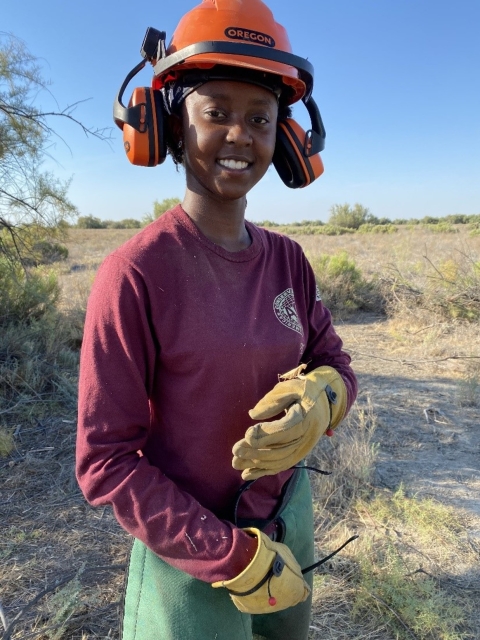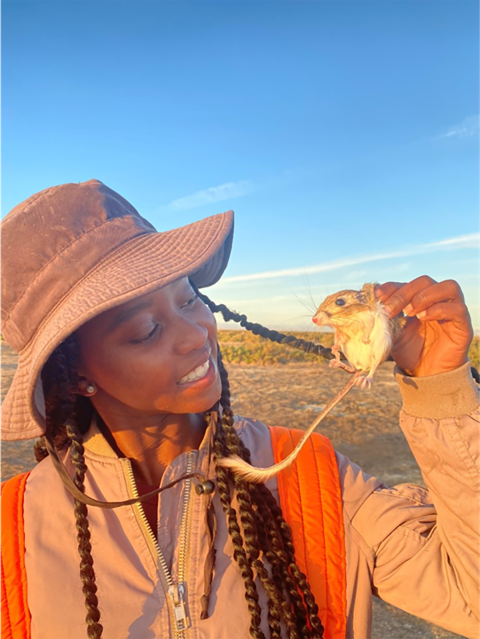Vanessa Morales (VM): Hey, Ayanna, welcome to the U.S. Fish and Wildlife Service! What can you tell me about your Pathways internship?
Ayanna Browne (AB): Hey Vanessa! I started my Pathways internship back in mid-April and I am working on an outreach project to educate anglers about bird entanglements. This work is supported as part of restoration efforts following the Refugio Beach oil spill that impacted the Gaviota coast in 2015. I am coordinating meetings with stakeholders to put together a consistent message for anglers about what to do if they come across an entangled bird.
VM: Such an important project! Where did you go to school for your undergraduate degree and what did you study?
AB: I attended Tuskegee University, designated an HBCU or historically Black college or university, in Alabama, where I studied animal sciences.
VM: What made you want to study animal sciences?
AB: I am from the U.S. Virgin Islands and was one of those kids who always wanted to be outside. I grew up around a lot of nature, but not knowing much about it. My family had a lot of pets, so I decided I wanted to be a veterinarian. I didn’t only want to help pets, though. I wanted to be a wildlife veterinarian until I realized vet school wasn’t for me. I decided I wanted to be outside rather than in an office or clinic, so I changed my path.
VM: Wow, I can see how growing up in the Caribbean would make you appreciate the outdoors! Did you go straight into your master’s program after that?
AB: I took the time to gain some experience and knowledge about how working in the outdoors with wildlife would look like as a career path. After graduating in 2018, over the course of five years I did six different internships. I started in an HBCU Internship at Joshua Tree National Park doing desert tortoise tracking. After that, I was doing public outreach at Mark Twain National Forest. Next, I went to Pike and San Isabel National Forest in Colorado to monitor for pre-preparation of timber cutting and monitoring nesting birds like goshawks.
After my roles with the government, I did invasive species invasive species
An invasive species is any plant or animal that has spread or been introduced into a new area where they are, or could, cause harm to the environment, economy, or human, animal, or plant health. Their unwelcome presence can destroy ecosystems and cost millions of dollars.
Learn more about invasive species removal for the Audubon Society at Corkscrew Swamp Sanctuary in Florida. While I was there, I learned a lot about wetland birds and plants. Then, at Nemours Wildlife Foundation in South Carolina, I monitored red-cockaded woodpeckers and other species.
VM: Sounds like you’ve had so many wonderful experiences! When did you decide to go back to school?
AB: In some of my later internships, I realized I was somewhat stagnant. I was collecting data but wasn’t getting the chance to do anything with it. I wanted data analysis experience, so I decided to search for a program, but needed it to be fully funded. For two years, I reached out to professors with the idea of studying invasive snakes in the U.S. Virgin Islands. Eventually, I found a program that wanted someone from the Caribbean to do research in the Caribbean focusing on this issue. The professor told me they were not trying to only do research, they wanted to engage the public, too. The program was funded, in the Caribbean, had data analyzation, and outreach. It checked all the boxes for me. So, I went back to school!
VM: You held out to find the perfect opportunity! That’s fantastic. With all these experiences, is there a particular project or moment you’re really proud of?
AB: My last internship at Kern National Wildlife Refuge was one I enjoyed the most. Even though I was working on cutting down massive salt cedar shrubs and doing lots of hard manual labor with chainsaws and a skid-steer, I got to participate in all parts of the project. The crew at Kern worked together to solve issues. We did lots of plant and animal surveys for the blunt-nosed lizard, kit foxes, and most importantly, the endangered Tipton kangaroo rat. The Kern team also manages the Pixley National Wildlife Refuge, where we counted over 10,000 sandhill cranes flying off the refuge. That was really amazing. The team was really small and diverse, too.
VM: Sounds like a really special experience! Why is diversity important to you in the field of conservation?
AB: For me, it is important because it allows me to feel comfortable. When you see someone that looks like you, you start to open up more and not feel like you have to keep your guard up all the time when communicating. If you see someone that looks like you or even just a person of color, it's like, “okay, maybe I can relax.” They live here, they work here, or they come out here frequently. And seeing that, I know I'm going to be okay, if they’re okay. It's the best thing when you just see people of various backgrounds and race and experiences come together and work well together. Kern was a prime example of showing how well we can all just work together no matter what.
VM: Thank you for sharing those sentiments! I am so glad you had such a positive experience at Kern. So, you’ve done all these programs and internships, but how do you spend your free time?
AB: I do like to go out hiking, birdwatching, camping if I can, and being out in nature. I like to find my peace and my calm in it. Being in the city now, I crave that. I like to hear the little things and not cars on a road or people talking.
VM: Thank you Ayanna, it was wonderful to get to know you! We are so lucky to have your vast experience at the Service!





